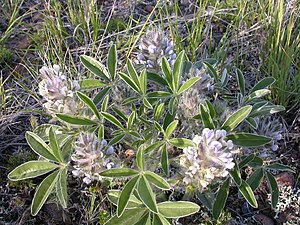Prairie turnip
| Prairie turnip | ||||||||||||
|---|---|---|---|---|---|---|---|---|---|---|---|---|

Prairie turnip ( Pediomelum esculentum ) |
||||||||||||
| Systematics | ||||||||||||
|
||||||||||||
| Scientific name | ||||||||||||
| Pediomelum esculentum | ||||||||||||
| ( Pursh ) Rydb. |
The prairie turnip ( Pediomelum esculentum , Syn. : Psoralea esculenta ) is a lupine-like plant from the family of legumes (Fabaceae). It is a character species of the prairie , which in earlier times also represented an important crop that was wildly harvested by the Indians and later also by the first settlers. Nowadays this legume only plays a certain role in the nutrition of the inhabitants of the Indian reservations, but it has probably been cultivated on various occasions.
Species description
The prairie turnip is a low, upright herb with one or more sturdy flower stalks that reach six to eight inches. The main stems grow from an egg to spindle-shaped, bulbous, thickened root, which can reach up to 5 cm in diameter and is covered by a thick, brown, somewhat leathery bark.
The green foliage, which is densely covered with silvery hair, has five fingers, similar to lupins.
The dark blue flowers are densely packed in spike-like clusters. With age, the flowers fade and take on a lavender-like color. The flower buds are also very hairy, silvery. Flowering is from May to June.
The fruits are narrow pods , each with a pea-like seed. Since the above-ground parts of the plant wilt soon after blooming and are then very brittle, they are torn off by the wind and the seeds are spread. The plant is perennial for several years .
particularities
This butterfly has nutrient- storing tubers , which used to be an important permanent source of food for the Prairie Indians and are still used today for traditional cuisine. This tuber was known to the trappers as “pomme blanche”, in today's reserve English it is called “wild turnip” or simply “turnip”.
The radish-sized tubers are dug up, peeled and eaten after flowering (but before the withered plants break off). They can be eaten raw or cooked. Peeled, they are whitish light. When dried, they are braided on their root strands, like garlic chains , and can be stored for a long time. They are still available today in trading post shops. The taste is somewhat nutty, the consistency floury and slightly sticky.
distribution
The prairie turnip is common in the prairie biotopes from southern Canada to Oklahoma , across Wisconsin and the entire Great Plains , but never in dense occurrences. To the west, the prairie turnip can be found as far as Colorado and Montana . Preferred locations are hill slopes in the prairie, it is rarely found in the lowlands.
Other names
- English: Wild Turnip , Prairie Turnip , Breadrood (scurfpea)
- Lakota: thíŋpsiŋla (roughly: 'prairie starch nodules')
- Dakota: thíŋpsiŋna
swell
- Gilmore, Melvin R., Uses of Plants by the Indians of the Missouri River Region, Lincoln / Nebraska, 2nd ed. 1991
- Johnson, James R./Larson, Gary E., Grassland Plants of South Dakota and the Northern Great Plains, Brookings, SD 1999
- Netzel, Rebecca, Animal Nation and Plant Nation, A Fieldguide for Lakóta Children and for all those adults who still care about Creation, Trier 2007
- Van Bruggen, Theodore, Wildflowers, Grasses and Other Plants of the Northern Plains and Black Hills, Rapid City, 5th ed. 2003
- Venning, Frank D., A Guide to Field Identification - Wildflowers of North America, New York / Racine, Wisconsin 1984
Web links
- Psoralea esculenta inthe IUCN 2013 Red List of Endangered Species . Posted by: Contu, S., 2010. Retrieved May 12, 2014.
